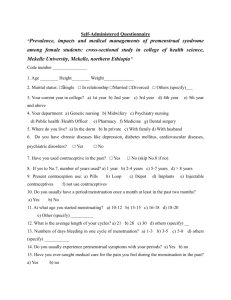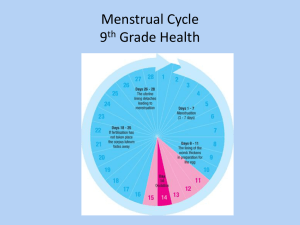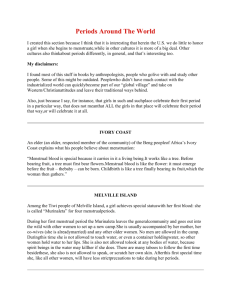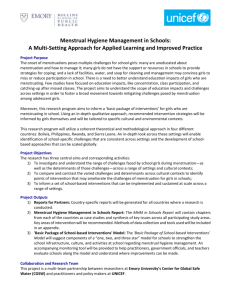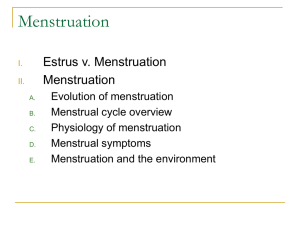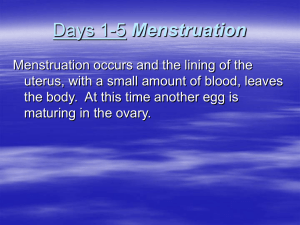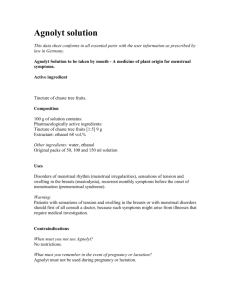Paradoxical constructions of self: Educating young women about
advertisement
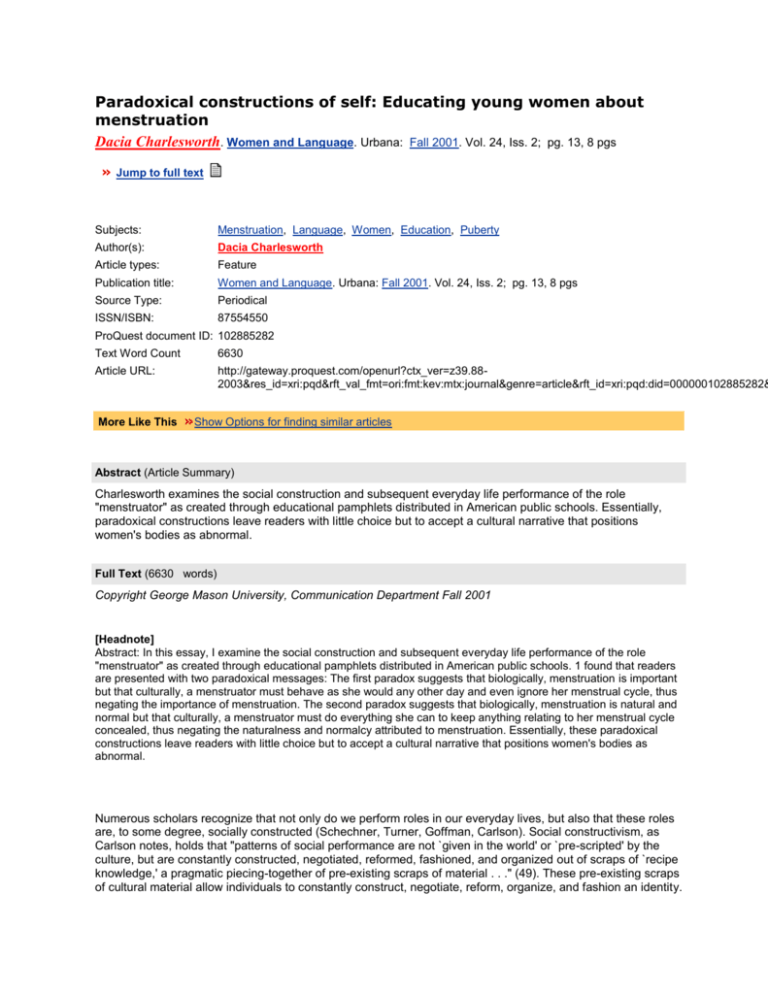
Paradoxical constructions of self: Educating young women about menstruation Dacia Charlesworth. Women and Language. Urbana: Fall 2001. Vol. 24, Iss. 2; pg. 13, 8 pgs » Jump to full text Subjects: Menstruation, Language, Women, Education, Puberty Author(s): Dacia Charlesworth Article types: Feature Publication title: Women and Language. Urbana: Fall 2001. Vol. 24, Iss. 2; pg. 13, 8 pgs Source Type: Periodical ISSN/ISBN: 87554550 ProQuest document ID: 102885282 Text Word Count 6630 Article URL: http://gateway.proquest.com/openurl?ctx_ver=z39.882003&res_id=xri:pqd&rft_val_fmt=ori:fmt:kev:mtx:journal&genre=article&rft_id=xri:pqd:did=000000102885282& More Like This »Show Options for finding similar articles Abstract (Article Summary) Charlesworth examines the social construction and subsequent everyday life performance of the role "menstruator" as created through educational pamphlets distributed in American public schools. Essentially, paradoxical constructions leave readers with little choice but to accept a cultural narrative that positions women's bodies as abnormal. Full Text (6630 words) Copyright George Mason University, Communication Department Fall 2001 [Headnote] Abstract: In this essay, I examine the social construction and subsequent everyday life performance of the role "menstruator" as created through educational pamphlets distributed in American public schools. 1 found that readers are presented with two paradoxical messages: The first paradox suggests that biologically, menstruation is important but that culturally, a menstruator must behave as she would any other day and even ignore her menstrual cycle, thus negating the importance of menstruation. The second paradox suggests that biologically, menstruation is natural and normal but that culturally, a menstruator must do everything she can to keep anything relating to her menstrual cycle concealed, thus negating the naturalness and normalcy attributed to menstruation. Essentially, these paradoxical constructions leave readers with little choice but to accept a cultural narrative that positions women's bodies as abnormal. Numerous scholars recognize that not only do we perform roles in our everyday lives, but also that these roles are, to some degree, socially constructed (Schechner, Turner, Goffman, Carlson). Social constructivism, as Carlson notes, holds that "patterns of social performance are not `given in the world' or `pre-scripted' by the culture, but are constantly constructed, negotiated, reformed, fashioned, and organized out of scraps of `recipe knowledge,' a pragmatic piecing-together of pre-existing scraps of material . . ." (49). These pre-existing scraps of cultural material allow individuals to constantly construct, negotiate, reform, organize, and fashion an identity. Not surprisingly, such pre-existing scraps of cultural material are often gendered. West and Zimmerman argue that the performance of gender in everyday life is "more than the continuous creation of the meaning of gender through human actions . . . gender itself is constituted through interaction" (129). Gender, as a performative role, is communicated rhetorically and is enacted or "known" through the body; hence, ritual performances serve as sites to examine how gender is constituted through interaction. One type of ritual performance that focuses specifically on the female body and is thus useful in examining gender construction is menstrual education lessons. In general, menstrual and puberty education lessons are the only rituals in which American adolescents mark their transformation from child to young adult. In this essay, I argue that these lessons of menstrual education, significant in the lives of adolescent girls, offer paradoxical constructions of "woman" and on the whole mark women's bodies negatively. I begin by examining the format of puberty and menstruation education lessons. Next, I explore the paradoxical constructions of menstruation in the pamphlets and then discuss the implications of these paradoxes. Puberty and Menstruation Education Lessons Puberty and menstruation education lessons have been presented in public schools with little change for over fifty years. Somewhere between the ages of eight and thirteen, students attending American public schools will most likely take part in one such lesson. These lessons are conducted to inform girls and boys about their changing bodies. A teacher, who may not have been specifically trained to present material about puberty, usually presents this information. Teachers who have not received specific training are provided with a teacher's guide that supplements the information students receive. Some teachers call upon trained individuals to present the material. Tampax, for example, established its "education department" in March of 1941 and offered its services via the "Tampax lady" first to colleges and then to secondary and elementary schools. Due to this longstanding relationship, Tampax's education department continues to shape the curricula of many health education programs by providing informative pamphlets and activities to schools across the country (Tampax). In fact, Tambrands. reported that in 1991 their company "educated" twenty percent of the 1.8 million thirteen-year-old girls residing in the United States (Houppert 41). Other manufacturers of menstrual products also influence health education curricula as they produce every pamphlet distributed to girls during menstrual education lessons. The general format of the puberty education lessons also has remained fairly constant. Boys and girls are usually separated from each other for a short discussion summarizing puberty. This discussion is followed by a video and a question and answer session in which boys and girls remain separated. The separation reifies the differences between the bodies of boys and girls and reinforces the notion that girls and boys should not discuss their reproductive organs or functions with each other. Of course, it does make sense that by separating the girls and boys, they might be more comfortable when asking questions about their bodies. But this comfort level that boys and girls may feel when talking about issues surrounding the body with their own sex, and the awkwardness or embarrassment they may experience when talking to another sex, points to the pre-conditioning of students before officially learning about puberty. Either during or after the video and discussion, girls are always provided with a pamphlet that describes menstruation and free samples of menstrual products. These pamphlets, static and easily reviewed, provide girls with important cultural cues about performing the role of menstruator successfully. Menstruation Education Pamphlets To determine the various types of messages girls have received about menstruation during the past fifty years, I conducted a general search to determine what was and is available to health educators concerning menstruation. I located seven menstrual education pamphlets ranging in print dates from 1959 to 1998. These pamphlets were and are distributed to public schools across the nation, making the sample reflective of the information received by American girls aged eight to thirteen who attend public schools. As noted above, manufacturers of menstrual products produced every menstrual education pamphlet. The producers of these pamphlets include Tambrands (makers of Tampax tampons), Kimberly-Clark (makers of Kotex tampons and pads), Scott Paper Company (makers of Confidents tampons), the Campana Corporation (makers of Pursettes tampons), the Personal Products Corporation (makers of Modess pads), and the Bayer Corporation (makers of Midol pain reliever). I examined how these pamphlets constructed the ideal menstruator, finding them to offer paradoxical constructions of "woman." These paradoxical constructions work on at least two different levels and with two types of narratives. The first narrative, a scientific narrative, focuses on explaining the menstrual cycle. Indeed, the scientific language used to describe the menstrual cycle is, like most scientific language, detached and impersonal. The second narrative, a cultural narrative, focuses on the lived experiences a menstruator will encounter and is more personal. The cultural narrative emphasizes the menstruator's social responsibilities. These narratives are paradoxical in two primary ways. First, the authors invite readers to view the menstrual cycle as a significant change in readers' lives; then, readers are told that menstruation is trivial. Second, the authors stress that the menstrual cycle is natural and normal; and then encourage readers to keep menstruation secret. As I will demonstrate, it is through these linguistic paradoxes that young women may come to view their bodies as abnormal. Menstruation as Significant, Yet Trivial The first bit of information readers encounter in the menstrual education pamphlets includes a discussion detailing how menarche, the onset of menstruation, will affect them. The cultural narrative constructs menarche as significantly changing the lives of the readers and as cause for celebration. Menarche is said to be "one big 'first' for girls during puberty" (A Time for Answers 9), "an experience that will make a big change in you" (You're a Young Lady Now 1), a "miraculous change" (World of a Girl i) "one of the most important things that happen during this exciting period of growing up" (Growing Up Women and Language, Volume XXIV, No. 2, Page 14 and Liking It 4), "one of the most important signs that you are maturing" (Getting to Know Yourself 3), and part of the bridge "you cross which takes you from being a child to an adult" (Body Talk 2). Very Personally Yours offers the most extensive example of the significance of menstruation: From your earliest chalk-and-blackboard days, you've looked forward to your graduation-- dreamed of it, with stars in your eyes. It's as though, all your young life, you've been waiting on tiptoe for the very special day that would mark the commencement of a wonderful adventure: your debut into the adult world. So, too, your physical self has been preparing for another momentous adventure: your graduation from 'little girl' to grown-up. This slow body process has been at work so quietly you were scarcely aware of it. Then, one day you knew. You began to menstruate. (2) This excerpt acknowledges the performative nature of the menstrual cycle: menarche is an act that "marks" participants and is a key event that allows young women access to the adult world via their "debut." By situating menarche in the past, the authors' tone suggests that once readers begin menstruating they will be "insiders" and "part of the club." Thus, menarche is constructed as a significant event that serves as the primary measure by which girls may consider themselves "mature" or "grownup." Growing up, according to the authors, is exciting, and once girls enter the transitional phase of maturity (menstruation) they can think of themselves as mature. Clearly, the beginning of the menstrual cycle is to be an important event in readers' lives. Even though the authors stress the importance of menstruation, they devalue its significance. For example, one pamphlet says: "The average healthy girl looks upon her menstrual period days as she does any other" (Very Personally Yours 9) and another that "There is no reason why this time of the month should be any different from any other as far as your social life is concerned" (Getting to Know Yourself 3). These claims work on several different levels. First, what reader would not want to be identified as an "average healthy girl"? To be such, according to the pamphlet, she must not think of her period as unusual or special and when in public she must behave the same as she does when she is not menstruating. Second, these statements encourage girls to think of their periods as a routine part of their lives. This may be positive; however, by encouraging readers to consider the days they menstruate to be the same as other days of the month negates the supposedly "miraculous" and significant nature of menstruation discussed earlier. Readers also are instructed to discount evidence of their impending period: "You may notice a small twinge or two at the time of ovulation. It's normal. Just ignore it!" (Very Personally Yours 8). What was described just two pages earlier as "Nature's perfect plan," and the important event that transformed girls into women, is now just a twinge that can be ignored. Not only are readers told to ignore the physical manifestations of menstruation, they are also told to ignore the entire process of menstruation: "Once you understand it, and how little bother it need be, paying attention to it makes about as much sense as worrying over your breathing" (You're a Young Lady Now 7); and "Far from being mysterious, menstruation is a very commonplace routine. In fact, it's so right and normal that once you understand menstruation and how little bother it need be, paying attention to it makes about as much sense as brooding over your digestive process" (Very Personally Yours 5-6). Clearly, readers' understanding of the menstrual cycle is privileged over the bodily experience of menstruating. Within these sections, the authors reify the mind/body split and effectively argue that this bodily process is important to understand but should not be witnessed or even thought about in everyday life. This position not only encourages readers to discount the phenomenological experiences of menstruation but also any activities relating to the body. Authors' further emphasis on reasons to ignore menstruation occurs by identifying menstrual flow as "material that is not needed" (World of a Girl 5), "unneeded tissue" (Getting to Know Yourself 9) and liken it to discarded bodily materials such as fingernails, eyelashes, hair (Very Personally Yours 6), and perspiration (Growing Up and Liking It 9). Now, this event that marks a major change in a girl's life equates to breathing, digestion, and sweat. The authors may be attempting to reduce the anxiety some girls may feel about menstruating by making it appear to be nothing special or nothing out of the ordinary; yet, by making menstruation appear trivial, the message of its significance is contradicted. By reducing the significance of menstruation and by equating it to breathing, digestion, and perspiration, the authors also encourage readers to think of menstruation as an event that should not be mentioned or observed. After all, who describes their problems with halitosis, digestion, or perspiration or wants to let others smell their breath, hear the digestive system at work, or see them sweat? Hence, menstruation is categorized with other bodily or hygienic "problems" that individuals must work constantly to conceal. The scientific narrative also constructs the menstrual cycle as both significant and trivial. In The Woman in the Body, Martin found that the dominant metaphors in medical discourse construct women's bodies as "a hierarchical, bureaucratically organized system under control of the cerebral cortex and a manufacturing plant designed for production of babies" (172-173). In her evaluations of definitions and descriptions of menstruation in medical textbooks, she discovered that menstruation was defined as failed reproduction (47). I found that these educational pamphlets describe menstruation similarly. All describe menstruation in terms of deficiency and loss, although varying in the degree to which they mark women's bodies as inefficient. Some descriptions are blatant: The body always has a way of dispensing with material that is not needed. Since the thickened lining of the uterus is now useless, the body sheds it off. This lining, a mixture of blood and watery tissue, for several days flows slowly out of the body through the vaginal channel, shown in the drawing, and must be absorbed by sanitary pads. (World ofa Girl 6) And, as "sanitary" pads must be used to absorb the menstrual flow, the authors also construct it as unsanitary. Other descriptions are less explicit: "If the egg isn't fertilized, your body knows that it doesn't need its 'nest' any longer. It then begins to shed the endometrium. In other words, you get your period. . ." (A Time for Answers 21). These authors do not define menstruation as negatively as the other pamphlets; however, readers are again told that the "nest," or what becomes the menstrual flow, is not needed. Viewing menstruation as a deficiency and in terms of loss stands in direct opposition to the celebratory nature of menstruation, but the definition specifically highlights what is to be celebrated when menarche arrives, that the woman can now reproduce. No mention is ever made that menstruation signals that a woman's body is healthy; instead, the primary reason to celebrate menstruation is that readers may now join the "productive" ranks of motherhood. The pamphlets do not mention that reproduction occurs via sexual intercourse, yet menstruation is repeatedly connected to motherhood: "The menstrual cycle is very closely linked to one of the most important physiological functions of all women: reproduction" (Getting to Know Yourself 7); "The normal girl accepts it [menstruation] as a normal reminder that her body is being prepared for the important job of bearing children some day" (World of a Girl 6); and "In years to come, when you are married and have a baby, that is where the baby will grow" (You're a Young Lady Now 3). While these pamphlets describe menstruation in terms of loss and deficiency they also celebrate the fact that menstruators will be able to produce children. By celebrating motherhood, the authors encourage readers to perform the socially sanctioned role of mother. Thus, the first paradox suggests that the menstrual cycle is important to understand because of its significance in reproductive terms but that a menstruator should treat it casually, behaving as she would any other day, even ignoring the menstrual cycle. Menstruation as Natural and Normal, Yet Secret Even as the pamphlets describe menstruation as a significant change in readers' lives, albeit from a natural Women and Language, Volume XXIV, No. 2, Page 15 and normal function of the menstrual cycle, they then encourage readers to keep menstruation a secret. The authors emphasize the natural and normal function of the menstrual cycle by making it a central focus of these pamphlets. On average, the authors of these pamphlets use the words "natural" and "normal" to describe or define menstruation eleven times in each pamphlet. For example, readers are told that menstruation is a "normal, routine part of your life" (Very Personally Yours 1), a "natural part of being a girl-a natural part of growing up" (You're a Young Lady Now 4), and that "this monthly flow of blood is a perfectly normal, natural body function" (Getting to Know Yourself 3). Notice that the menstrual cycle is mostly discussed in abstract terms: menstruation is part of a girl, is a bodily function. Thus, the menstrual cycle appears natural and normal but what is omitted from this discussion are the phenomenological aspects of menstruation. Obviously, one of the objectives of these pamphlets is to inform readers about menstruation; however, when defining the menstrual cycle, the authors continue to separate or distance menstruation from readers' bodies. The Body Talk pamphlet provides a representative example of how menstruation is usually defined and distanced from readers' bodies: 1. The menstrual cycle or period starts once a month when hormones cause an egg in an ovary to mature. 2. The ripened egg moves into the fallopian tube and travels down toward the uterus. 3. Meanwhile the uterus develops a thick spongy cushion of blood-filled tissue. If the egg has not been fertilized, the thick lining of the uterus begins to shed and flows out of the vagina for the next two to nine days, although the average is generally three to five days. 4. It is this time when a woman bleeds that is called a menstrual period, menstruation, or just a period. Quite often the blood may look different than blood from a cut-it may be darker, thicker or more brownish in color. This is normal. (5) The authors are surely certain of their audience: readers about to begin menstruating. Yet, they discuss the menstrual cycle, an egg, an ovary, the fallopian tube, the uterus, and a woman. Nothing in this definition indicates to the reader that the menstrual cycle will soon begin in her body; rather, the menstrual cycle occurs in a generic female body. Only one pamphlet, You're a Young Lady Now departs from this pattern: Regularly, once a month, your body builds a spongy lining of blood and watery fluids inside Women and Language, Volume XXIV, No. 2, Page 16 the uterus. When the fluids are not needed, they flow away through an opening inside the lower front part of your body called the vagina. (The vagina is located near the opening through which you urinate.) This building-up and flowing-away process goes on for many years. (3, my emphasis) Although this description still contains generic articles (e.g., the vagina, the uterus), the first person articles bring the reader into the process and helps readers think of menstruation as something that occurs within their bodies rather than something that occurs to their bodies. This distinction is significant because if women consider menstruation as an event in which they are actively, rather than passively, participating, then presumably they will be able to think of menstruation in more positive terms. Most descriptions, however, cast menstruation as an event that happens to women, suggesting menstruation is separate from readers' bodies and position menstruators as passive observers of the process. This separation may contribute to the shame surrounding menstruation because if readers can separate menstruation from their bodies, then they can be ashamed of the menstrual cycle rather than themselves. In another construction of menstruation as natural and normal, the authors connect the menstrual cycle to nature itself, which positions "Nature" as an outside controlling force and encourages readers, once again, to consider the menstrual cycle as separate from their bodies. For example, "Nature always plans carefully for the life ahead" (World of a Girl 6), and "Nature builds a lining of special tissue inside the uterus about once each month to prepare a nesting place in which a baby can develop" (Growing Up and Liking It 4). One pamphlet includes a quote from a "wise" doctor who notes, "Nature has arranged that by the time a girl begins to menstruate, she has also acquired enough common sense to accept it as a normal process" (World of a Girl 7). By associating menstruation with something developed by Nature, the authors persuasively link "Nature "natural," and "normal" to menstruation. Perhaps the best example of this link is "Mother Nature, of course, is no fortune teller, and can't be sure whether or not the egg will be fertilized. But she takes no chances. She's ready every month, for she knows that if the uterus is to cradle the seed of a new life, it must be ready to provide nourishment and protection" (Getting to Know Yourself 7). "Nature" now becomes "Mother Nature," a shrewd move by the authors that sets up the following syllogism: Mother Nature controls women's bodies; Women menstruate; therefore, Mother Nature controls menstruation, thus menstruation must be natural. In addition, Nature, herself a mother, enables others to become mothers. This link implies that not only is menstruation natural but that being a mother is natural as well. The authors use considerable space conveying the idea that menstruation is a normal and natural part of being a girl, woman, or grown-up but seldom discuss menstruation as a process that will occur within readers' bodies. Although the authors claim that menstruation is a natural and normal biological process, they encourage readers to keep this "natural and normal" process a secret. Apparently, if menstruation is a passage into womanhood, as noted above, then it is meant to be a silent and secret journey. The pamphlets caution that menstruation should not be discussed with just anyone: "It's a natural part of being a girl-a natural part of growing up-but it's a very personal thing, so you won't want to discuss it with anyone else except your mother, school nurse, or adviser" (You're a Young Lady Now 4, my emphasis). The notion of secrecy is still present in one of the most recent pamphlets published (Tampax). In its question and answer section someone asks, "Can anyone tell I have my period?" The reply is: "No. Unless you tell someone, it's your secret" (40, my emphasis). Readers might wonder why secrecy and silence should surround a natural and normal process. The authors constantly remind readers they need to conceal the fact that they are menstruating. The theme of secrecy is paramount in all the pamphlets. In the You're a Young Lady Now, readers are told, "The napkin is kept firmly in place by fastening it, front and back, to an elastic belt that you wear around your waist next to your skin. NOTHING SHOWS, so no one else knows you are wearing your belt and napkin" (5). Young women are also encouraged to keep an inexpensive handbag filled with sanitary napkins in their locker at school. By doing so, no one will be able to see their menstrual products when they open their lockers (Growing Up and Liking It 24). This last comment is particularly telling because it implies that even unused menstrual products must be kept out of sight and sets into place the secret and taboo nature of anything relating to menstruation. Along those same lines, readers are also instructed to keep a "little dark plastic bag" filled with a belt and sanitary napkins in their handbags (Growing Up and Liking It 24). To completely hide their period from others, readers are told that when disposing of their napkins, they may want to keep a "supply of small brown paper bags for disposal purposes . . . particularly lady-like when you are visiting in someone's home" (Growing Up and Liking It 25). This statement obviously implies that menstruation, or anything relating to menstruation, is anything but "lady-like." And the strategy of carrying around a "supply of small brown paper bags" suggests to readers that they must be willing to inconvenience themselves so that others will not have to witness any evidence of their menstrual cycle. Menstrual products also are discussed in terms of their ability to conceal the fact that a woman is menstruating and thus keep it secret: "And because tampons are completely invisible, there's not a chance of ridges or bulkiness showing when wearing sheer dresses or close-- fitting play clothes" (Getting to Know Yourself 13). Readers are told that a properly selected sanitary belt will keep napkins "smooth, neat, and undetectable" (Growing Up and Liking It 22, my emphasis) and "Remember, you are the only one who knows you are wearing sanitary protection" (World of a Girl 13). Readers are told that an entire box of Pursettes tampons can be "tucked into the tiniest purse" (hence the name) and that each one is no larger than a lipstick (Getting to Know Yourself 17, 16) as well as that Tampax Compak Tampons are "small enough to fit in a pocket or small purse" (A Time for Answers 29). The authors stress that even maxi-pads have been designed to keep a menstruator's identity a secret. Kotex sanitary napkins are successful because the flat pressed, tapered ends prevent revealing outlines, regardless of what readers wear (Very Personally Yours 16; You're a Young Lady Now 14). Confidents pads benefit users because both ends of the pad are slim and flat to fit under leotards, slacks, shorts, or slim skirts and not be seen (World of a Girl 12). Again, the message is clear: it is acceptable to know about menstruation but one should never let others know that she is menstruating. The makers of menstrual products claim technological advances to ensure that menstruation is kept secret, placing themselves in an important position as they assist readers in "protecting" their identities as menstruators. Modess sanitary napkins have an "undetectable deodorant for daintiness and an accident-safe polyethylene shield to prevent moisture `strike-through"' as well as a napkin that has a "Vee-Form," a softly contoured pad to "echo the lines of your body" (Growing Up and Liking It 20). Kotex napkins include a "Kimlon center." These centers are supposed to greatly increase absorbency, although readers are never told how (Very Personally Yours 16; You're a Young Lady Now 11). Confidents contain a "V-shape" as well as a "moisture proof inner shield" (World of a Girl 13). Tampax tampons also are touted because with the biodegradable applicator, "you can simply flush them away. That helps the environment. And it's a good way to help keep your period private" (A Time for Answers 29). Pursettes contain an "exclusive tapered, pre-lubricated tip that does away with the need for a bulky cardboard applicator which eliminates the applicator-disposal problem entirely" (Getting to Know Yourself 16). The makers of menstrual products also work diligently to make menstruation and their products appear to be ultra-feminine. Modess napkins are attached to a "dainty" waistband (22); its most popular style of this pad was the "Princess" (22). Other belts had a "delicate pink frill" (22). Pursettes tampons "blossom out" (like a flower) when they contact moisture (Getting to Know Yourself 16). Modess pads' have an "accident-safe shield of soft, moisture-proof polyethylene and a deodorant to protect your freshness. It's quite special . . . and so reassuring. You'll love this added bit of femininity (21). Teen-Age Modess pads also have a "dainty blue design" on the TeenAge Modess (Growing Up and Liking It 21). All of the authors' obvious work toward making these products appear feminine suggests that menstruation or, more Women and Language, Volume XXIV, No. 2, Page 17 specifically, the act of menstruating is not "naturally" feminine, quite a contradiction to the rhetoric of naturalness. Another way the authors discount the notion of menstruation being natural and normal is the focus on the lack of guarantee that menstruators' identities can always be concealed. In fact, according to the pamphlets, almost every woman will experience an "hygienic crisis." Readers, addressed in a direct manner, are warned that not only could they be caught menstruating but that this discovery would be dreadful. The pamphlets make clear that one of the most horrible aspects of becoming a menstruator is the chance, however small, of others discovering that she is menstruating. Every pamphlet discusses the potential of this crisis and options for the poor soul whose protection has failed or, the more likely scenario, was not "protected" in the first place. One pamphlet even advises young girls to be prepared for their period any time after their tenth birthday (World of a Girl 14). The others stress that young women do not want to be caught off guard when their period begins and so should always be prepared with "sanitary protection." The authors of these pamphlets make it clear that without bodily surveillance and preparation, the menstruators will face dire consequences. To help readers avoid such a crisis, two of the pamphlets include a calendar or series of calendars to track the menstrual cycle. The calendar assists readers as follows: "A record of your period will help you to be prepared ahead of time. On the day that you expect the flow to start you can wear the belt and napkins, or take them with you in your purse so that there will be no accidents" (You're a Young Lady Now 12-13). This self-- monitoring may be needed for up to two years, as that may be the length before the menstrual cycle settles into a regular pattern (A Time for Answers 21). In actuality though, this type of self-monitoring will continue for the rest of the reader's life if she buys into the relationship established by the authors and our culture-at-large that positions a woman as a surveyor of herself as well as one who is surveyed by others. Readers receive the following instructions for using the calendars: "Every woman has her own special cycle. To help you figure out yours, keep this handy chart in your diary or wallet. Keep track of when you start and stop your period. Soon you will start to see a pattern and will get to know when to expect your period" (Body Talk 11). Also noteworthy: Young women are encouraged to keep this calendar out of view, in a diary or wallet, thus reinforcing the need to keep everything about menstruation secret. This may also be the first time in readers' lives that they are going to carry a purse-a symbol of womanhood. Several pamphlets recommend carrying purses so that sanitary protection may be stored there. The authors also assume that readers, or readers' families, are affluent enough to provide young women with a purse, a diary, or a wallet and that all readers will be able to afford extra Women and Language, Volume XXIV, No. 2, Page 18 menstrual products to keep in their lockers at school. One thing is certain, the role of ideal menstruator, like most other cultural identities, is clearly attained through consumption. The pamphlets make clear that without bodily surveillance (symbolized by the calendar) and preparation (symbolized by the "protection" stored in the purse or locker), the consequences will be dire. The Body Talk pamphlet provides extensive instructions for covering up if they have been "caught": When you first start having periods they are often irregular, so there may be a time when you get caught by surprise. Knowing how to handle these situations ahead of time can help prevent embarrassment if they actually happen. If you bleed through to the back of your clothes and people can see it tie a sweater, shirt or jacket around your waist so it covers the spot till you can get to the bathroom. If you're wearing a skirt, sometimes you can turn it around so the spot is in the front and you can hold your bag with books over it. One of the easiest things to do is to ask another girl to walk behind you to the bathroom so no one can see what happened. Sometimes it helps to keep a spare pair of underpants or jeans in your locker. Many women wear dark colored clothes during their period as stains often can't be seen as easily. If you get your period at school, you're in luck-- your school nurse will have a supply of pads on hand for you to use. If you're in class and you think you're bleeding, ask your teacher to be excused and go to the bathroom and check things out. Then see the nurse for some protection. Use toilet paper or paper towels to protect yourself until you get a pad. You may wish to keep some pads on hand in your locker, or one in your school bag just in case. If you're not in a place where you can get a pad or tampon you can use other things. A thick layer of toilet paper or paper towels will do the job temporarily. Other things include clean socks or even headbands and bandannas! (11) This excerpt, and those similar to it in other pamphlets, serves to strengthen the shame associated with being a menstruator in our culture. It highlights one reason menarche, rather than menstruation, is celebrated: If readers continue to celebrate menstruation beyond menarche, then they will not buy into the cultural narrative that positions menstruation as embarrassing and something that must be concealed at all costs. And if readers do not fear a "hygienic crisis," then the manufacturers of menstrual products would be unable to produce and sell all of the extra "protection" available to menstruators before, during, and after their periods. Thus, the second paradox demonstrates that biologically, the menstrual cycle is a natural and normal process even while cultural prescriptions require a menstruator to do everything she can to keep anything relating to her menstrual cycle concealed. Conclusions and Implications While these pamphlets ostensibly try to portray menstruation as a normal and natural process, the companies producing the pamphlets also are trying to sell their products. They do this primarily with the idea of a hygienic "crisis" and the resulting embarrassment were anyone to discover a menstruator's secret. This idea devalues the female body. The texts encourage readers not only to be insecure about their bodies because they differ from the male norm but also to be ashamed of this natural occurrence that distinguishes them from men. These pamphlets strongly encourage readers to perceive menstruation as something that should be kept secret and is, without a doubt, not even to be witnessed by others. Instructing young women to be secretive about menstruation reinforces the negative connotations surrounding menstruation and supports the idea that young women should be shamed and embarrassed if someone discovers they are menstruating. The paradoxical messages in these pamphlets give readers a scientific narrative that privileges the biological function of menstruation and a cultural narrative that positions menstruation as secret and taboo and positions women's bodies as abnormal. Believing the scientific narrative would encourage readers to think of the menstrual cycle as necessary but inefficient and separate from their bodies. Accepting the cultural narrative encourages readers to view their bodies as abnormal and unfeminine during menstruation. Thus, for almost one-half of their lives, women are encouraged to dismiss their menstrual cycle and are required to keep any evidence of their role as a menstruator completely hidden. These messages place women in an inescapable paradox: If readers believe that menstruation is a natural and normal event that transforms them, biologically speaking, into a "woman," why must they conceal any evidence of menstruation? The pamphlets may argue that menstruation is a significant event that transforms a girl, culturally, into a "woman," but they do nothing to make that a celebratory event other than claim that girls are now ready for a woman's role, motherhood. The tension between these narratives becomes most clear when examining the ways readers are addressed in these pamphlets. When discussing the positive effects of menstruation via the scientific narrative, the authors consistently use generic articles (e.g., the menstrual cycle is natural and normal). This language usage does not attribute the positive aspects of menstruation to readers but to some higher power (e.g., "Nature"). When discussing the negative effects of menstruation via the cultural narrative, however, the authors consistently address the readers directly (e.g., you will bleed and it will be messy and embarrassing). This language usage locates the negative aspects of menstruation directly on readers' bodies. The result of this language usage is that readers are not allowed to benefit from the significance of menstruation-after all, biology or nature is responsible for the process, not the reader-but are held solely responsible for keeping their identity as a menstruator secret-after all, the manufacturers of menstrual products have developed numerous products to "protect" readers from themselves and others. The true paradox, then, is that either way, readers can never win. Ultimately, these pamphlets offer readers a false dichotomy of essentialized experiences. In the scientific narrative, the menstrual cycle is removed from readers' bodies and is acceptable because it is a "natural" abstract process. In the cultural narrative, menstruation is discussed in concrete terms as it is applied to the readers' bodies and is viewed in a negative manner (e.g., menstrual blood is messy and embarrassing). In the end, these two narratives are not competing, per se; rather, the manufacturers of menstrual products have coopted scientific language to explain menstruation as well as negative cultural attitudes about menstruation to insure a future market for themselves. For without the "protection" of their products, the pamphlets make clear, readers cannot trust their own bodies and need to engage constantly in bodily surveillance. Thus, no matter if a reader considers menstruation to be significant/natural/ normal or trivial/secret/taboo, the manufacturers of menstrual products have commodified menstruation and will benefit from the objectification and exploitation of women's bodies on their own terms. Paradoxes such as these emphasize the complexities and difficulties inherent in performing the role "woman" in our culture. Only by deconstructing these seemingly "objective" messages could we become aware of and critique the harmful cultural representations of women and how these representations become reified through various performances in everyday life. [Reference] References [Reference] A Time For Answers. Palmer, Massachusetts: TAMBRANDS, Inc., 1992. Body Talk: Understanding That Time of the Month! Morristown, New Jersey: Bayer Corporation, 1998. Carlson, Marvin A. Performance: A Critical Introduction. New York: Routledge, 1996. Getting to Know Yourself. Batavia, Illinois: Campana Corporation, 1962. Goffman, Erving. The Presentation of Self in Everyday Life. New York: Doubleday, 1959. Growing Up and Liking It. Milltown, New Jersey: Personal Products Corporation, 1961. Houppert, Karen. The Curse. Confronting the Last Unmentionable Taboo: Menstruation. New York: Farrar, Straus, and Giroux: 1999. [Reference] Martin, Emily. The Woman in the Body: A Cultural Analysis of Reproduction. Boston: Beacon Press, 1987. Schechner, Richard. Between Theatre and Anthropology. Philadelphia: University of Pennsylvania Press, 1985. Tampax. "The Education Department." Tambrands, Inc. December 27, 1999. Turner, Victor. Dramas, Fields, and Metaphors. Ithaca, New York: Cornell University Press, 1974. From Ritual to Theatre: The Human Seriousness of Play. New York: PAJ Publications, 1982. Very Personally Yours. Neenah, Wisconsin: Kimberly-Clark Corporation, 1959. [Reference] Wood, Julia. Gendered Lives: Communication, Gender, and Culture. 4' edition. Belmont, California: Wadsworth Publishing Company, 2001. World of a Girl. Philadelphia: Scott Paper Company, 1960. You're A Young Lady Now. Neenah, Wisconsin: Kimberly-Clark Corporation, 1959. [Author Affiliation] Dacia Charlesworth (Ph.D., Southern Illinois University at Carbondale, 2000) is a Visiting Assistant Professor at Slippery Rock University of Pennsylvania. The author gratefully acknowledges many insightful observations contributed by Bill McKinney. Portions of this essay were adapted from the author's dissertation, directed by Suzanne M. Daughton. E-mail correspondence: dacia.charlesworth@sru.edu
